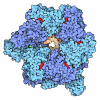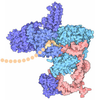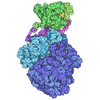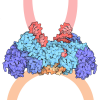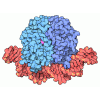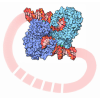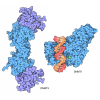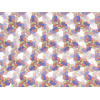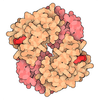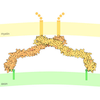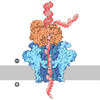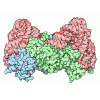[English] 日本語
 Yorodumi
Yorodumi- PDB-9mj5: Catalytic domain of human DNA polymerase alpha in complex with DN... -
+ Open data
Open data
- Basic information
Basic information
| Entry | Database: PDB / ID: 9mj5 | ||||||||||||||||||
|---|---|---|---|---|---|---|---|---|---|---|---|---|---|---|---|---|---|---|---|
| Title | Catalytic domain of human DNA polymerase alpha in complex with DNA and RPA | ||||||||||||||||||
 Components Components |
| ||||||||||||||||||
 Keywords Keywords | Replication/DNA/RNA / DNA replication / Replication-DNA-RNA complex | ||||||||||||||||||
| Function / homology |  Function and homology information Function and homology informationprotein localization to chromosome / DNA replication factor A complex / DNA replication initiation / Telomere C-strand synthesis initiation / Inhibition of replication initiation of damaged DNA by RB1/E2F1 / regulation of type I interferon production / alpha DNA polymerase:primase complex / Polymerase switching / Processive synthesis on the lagging strand / lateral element ...protein localization to chromosome / DNA replication factor A complex / DNA replication initiation / Telomere C-strand synthesis initiation / Inhibition of replication initiation of damaged DNA by RB1/E2F1 / regulation of type I interferon production / alpha DNA polymerase:primase complex / Polymerase switching / Processive synthesis on the lagging strand / lateral element / regulation of DNA damage checkpoint / single-stranded telomeric DNA binding / G-rich strand telomeric DNA binding / lagging strand elongation / Removal of the Flap Intermediate / chromatin-protein adaptor activity / protein localization to site of double-strand break / Polymerase switching on the C-strand of the telomere / Mismatch repair (MMR) directed by MSH2:MSH3 (MutSbeta) / Mismatch repair (MMR) directed by MSH2:MSH6 (MutSalpha) / mitotic DNA replication initiation / DNA replication, synthesis of primer / Removal of the Flap Intermediate from the C-strand / HDR through Single Strand Annealing (SSA) / regulation of double-strand break repair via homologous recombination / DNA strand elongation involved in DNA replication / DNA synthesis involved in DNA repair / telomeric DNA binding / Impaired BRCA2 binding to RAD51 / leading strand elongation / G1/S-Specific Transcription / hemopoiesis / Presynaptic phase of homologous DNA pairing and strand exchange / site of DNA damage / DNA replication origin binding / PCNA-Dependent Long Patch Base Excision Repair / DNA replication initiation / Regulation of HSF1-mediated heat shock response / Activation of the pre-replicative complex / HSF1 activation / telomere maintenance via telomerase / mismatch repair / Activation of ATR in response to replication stress / SUMOylation of DNA damage response and repair proteins / mitotic G1 DNA damage checkpoint signaling / homeostasis of number of cells within a tissue / telomere maintenance / regulation of mitotic cell cycle / Translesion synthesis by REV1 / Translesion synthesis by POLK / Translesion synthesis by POLI / Gap-filling DNA repair synthesis and ligation in GG-NER / Defective pyroptosis / meiotic cell cycle / male germ cell nucleus / nucleotide-excision repair / Fanconi Anemia Pathway / Termination of translesion DNA synthesis / Recognition of DNA damage by PCNA-containing replication complex / Translesion Synthesis by POLH / double-strand break repair via homologous recombination / base-excision repair / PML body / G2/M DNA damage checkpoint / HDR through Homologous Recombination (HRR) / double-strand break repair via nonhomologous end joining / Dual Incision in GG-NER / Meiotic recombination / DNA-templated DNA replication / Formation of Incision Complex in GG-NER / nuclear matrix / Dual incision in TC-NER / Gap-filling DNA repair synthesis and ligation in TC-NER / nuclear envelope / single-stranded DNA binding / regulation of cell population proliferation / site of double-strand break / Processing of DNA double-strand break ends / protein phosphatase binding / DNA recombination / Regulation of TP53 Activity through Phosphorylation / in utero embryonic development / DNA-directed DNA polymerase / damaged DNA binding / DNA-directed DNA polymerase activity / chromosome, telomeric region / DNA replication / nuclear body / DNA repair / nucleotide binding / positive regulation of cell population proliferation / DNA damage response / ubiquitin protein ligase binding / chromatin binding / protein kinase binding / chromatin / nucleolus / enzyme binding / DNA binding / zinc ion binding Similarity search - Function | ||||||||||||||||||
| Biological species |  Homo sapiens (human) Homo sapiens (human) | ||||||||||||||||||
| Method | ELECTRON MICROSCOPY / single particle reconstruction / cryo EM / Resolution: 3.5 Å | ||||||||||||||||||
 Authors Authors | Baranovskiy, A.G. / Morstadt, L.M. / Romero, E.E. / Babayeva, N.D. / Tahirov, T.H. | ||||||||||||||||||
| Funding support |  United States, 1items United States, 1items
| ||||||||||||||||||
 Citation Citation |  Journal: Nucleic Acids Res / Year: 2025 Journal: Nucleic Acids Res / Year: 2025Title: The human primosome requires replication protein A when copying DNA with inverted repeats. Authors: Andrey G Baranovskiy / Lucia M Morstadt / Eduardo E Romero / Nigar D Babayeva / Tahir H Tahirov /  Abstract: The human primosome, a four-subunit complex of primase and DNA polymerase alpha (Polα), initiates DNA synthesis on both chromosome strands by generating chimeric RNA-DNA primers for loading DNA ...The human primosome, a four-subunit complex of primase and DNA polymerase alpha (Polα), initiates DNA synthesis on both chromosome strands by generating chimeric RNA-DNA primers for loading DNA polymerases delta and epsilon (Polϵ). Replication protein A (RPA) tightly binds to single-stranded DNA strands, protecting them from nucleolytic digestion and unauthorized transactions. We report here that RPA plays a critical role for the human primosome during DNA synthesis across inverted repeats prone to hairpin formation. On other alternatively structured DNA, forming a G-quadruplex, RPA does not assist primosome. A stimulatory effect of RPA on DNA synthesis across hairpins was also observed for the catalytic domain of Polα but not of Polϵ. The winged helix-turn-helix domain of RPA is essential for an efficient hairpin bypass and increases RPA-Polα cooperativity on the primed DNA template. Cryo-EM studies revealed that this domain is mainly responsible for the interaction between RPA and Polα. The flexible mode of RPA-Polα interaction during DNA synthesis implies the mechanism of template handover between them when the hairpin formation should be avoided. This work provides insight into a cooperative action of RPA and primosome on DNA, which is critical for DNA synthesis across inverted repeats. | ||||||||||||||||||
| History |
|
- Structure visualization
Structure visualization
| Structure viewer | Molecule:  Molmil Molmil Jmol/JSmol Jmol/JSmol |
|---|
- Downloads & links
Downloads & links
- Download
Download
| PDBx/mmCIF format |  9mj5.cif.gz 9mj5.cif.gz | 284.7 KB | Display |  PDBx/mmCIF format PDBx/mmCIF format |
|---|---|---|---|---|
| PDB format |  pdb9mj5.ent.gz pdb9mj5.ent.gz | 217.5 KB | Display |  PDB format PDB format |
| PDBx/mmJSON format |  9mj5.json.gz 9mj5.json.gz | Tree view |  PDBx/mmJSON format PDBx/mmJSON format | |
| Others |  Other downloads Other downloads |
-Validation report
| Summary document |  9mj5_validation.pdf.gz 9mj5_validation.pdf.gz | 917.6 KB | Display |  wwPDB validaton report wwPDB validaton report |
|---|---|---|---|---|
| Full document |  9mj5_full_validation.pdf.gz 9mj5_full_validation.pdf.gz | 929.3 KB | Display | |
| Data in XML |  9mj5_validation.xml.gz 9mj5_validation.xml.gz | 41.2 KB | Display | |
| Data in CIF |  9mj5_validation.cif.gz 9mj5_validation.cif.gz | 65.3 KB | Display | |
| Arichive directory |  https://data.pdbj.org/pub/pdb/validation_reports/mj/9mj5 https://data.pdbj.org/pub/pdb/validation_reports/mj/9mj5 ftp://data.pdbj.org/pub/pdb/validation_reports/mj/9mj5 ftp://data.pdbj.org/pub/pdb/validation_reports/mj/9mj5 | HTTPS FTP |
-Related structure data
| Related structure data |  48312MC M: map data used to model this data C: citing same article ( |
|---|---|
| Similar structure data | Similarity search - Function & homology  F&H Search F&H Search |
- Links
Links
- Assembly
Assembly
| Deposited unit | 
|
|---|---|
| 1 |
|
- Components
Components
-Replication protein A ... , 3 types, 3 molecules ABC
| #1: Protein | Mass: 13583.714 Da / Num. of mol.: 1 Source method: isolated from a genetically manipulated source Source: (gene. exp.)  Homo sapiens (human) / Gene: RPA3, REPA3, RPA14 / Production host: Homo sapiens (human) / Gene: RPA3, REPA3, RPA14 / Production host:  |
|---|---|
| #2: Protein | Mass: 25931.359 Da / Num. of mol.: 1 Source method: isolated from a genetically manipulated source Source: (gene. exp.)  Homo sapiens (human) / Gene: RPA2, REPA2, RPA32, RPA34 / Production host: Homo sapiens (human) / Gene: RPA2, REPA2, RPA32, RPA34 / Production host:  |
| #3: Protein | Mass: 21031.748 Da / Num. of mol.: 1 Source method: isolated from a genetically manipulated source Source: (gene. exp.)  Homo sapiens (human) / Gene: RPA1, REPA1, RPA70 / Production host: Homo sapiens (human) / Gene: RPA1, REPA1, RPA70 / Production host:  |
-DNA/RNA hybrid / Protein / DNA chain , 3 types, 3 molecules PST
| #4: DNA/RNA hybrid | Mass: 3505.170 Da / Num. of mol.: 1 / Source method: obtained synthetically / Source: (synth.)  Homo sapiens (human) Homo sapiens (human) |
|---|---|
| #5: Protein | Mass: 103957.078 Da / Num. of mol.: 1 Source method: isolated from a genetically manipulated source Source: (gene. exp.)  Homo sapiens (human) / Gene: POLA1, POLA / Production host: Homo sapiens (human) / Gene: POLA1, POLA / Production host:  |
| #6: DNA chain | Mass: 10764.963 Da / Num. of mol.: 1 / Source method: obtained synthetically / Source: (synth.)  Homo sapiens (human) Homo sapiens (human) |
-Non-polymers , 3 types, 3 molecules 




| #7: Chemical | ChemComp-ZN / |
|---|---|
| #8: Chemical | ChemComp-MG / |
| #9: Chemical | ChemComp-DCP / |
-Details
| Has ligand of interest | N |
|---|---|
| Has protein modification | N |
-Experimental details
-Experiment
| Experiment | Method: ELECTRON MICROSCOPY |
|---|---|
| EM experiment | Aggregation state: PARTICLE / 3D reconstruction method: single particle reconstruction |
- Sample preparation
Sample preparation
| Component | Name: Ternary complex of DNA polymerase alpha with DNA and replication protein A Type: COMPLEX / Entity ID: #1-#6 / Source: RECOMBINANT |
|---|---|
| Molecular weight | Experimental value: NO |
| Source (natural) | Organism:  Homo sapiens (human) Homo sapiens (human) |
| Source (recombinant) | Organism:  |
| Buffer solution | pH: 7.7 |
| Specimen | Embedding applied: NO / Shadowing applied: NO / Staining applied: NO / Vitrification applied: YES |
| Vitrification | Cryogen name: ETHANE |
- Electron microscopy imaging
Electron microscopy imaging
| Microscopy | Model: TFS GLACIOS |
|---|---|
| Electron gun | Electron source:  FIELD EMISSION GUN / Accelerating voltage: 200 kV / Illumination mode: FLOOD BEAM FIELD EMISSION GUN / Accelerating voltage: 200 kV / Illumination mode: FLOOD BEAM |
| Electron lens | Mode: BRIGHT FIELD / Nominal defocus max: 2400 nm / Nominal defocus min: 800 nm |
| Image recording | Electron dose: 60 e/Å2 / Film or detector model: TFS FALCON 4i (4k x 4k) |
- Processing
Processing
| EM software | Name: PHENIX / Version: 1.21.2_5419: / Category: model refinement | ||||||||||||||||||||||||
|---|---|---|---|---|---|---|---|---|---|---|---|---|---|---|---|---|---|---|---|---|---|---|---|---|---|
| CTF correction | Type: PHASE FLIPPING AND AMPLITUDE CORRECTION | ||||||||||||||||||||||||
| 3D reconstruction | Resolution: 3.5 Å / Resolution method: FSC 0.143 CUT-OFF / Num. of particles: 18529 / Symmetry type: POINT | ||||||||||||||||||||||||
| Refine LS restraints |
|
 Movie
Movie Controller
Controller





 PDBj
PDBj

